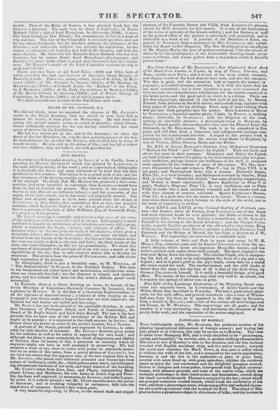The First Number of Mr. BnocKEnoN's New Illustrated Road Book
of the Routefroin London to Naples, by way of Turin, Florence, and Rome, carries us to Paris ; and it is one of the most useful, compact, and elegant works of the kind that we have seen, and also the cheapest. The idea is good, and the -execution, both as regards the matter, ty pography, and embeli,shments, excellent. It is with the latter that we are most concerned ; but it were injustice to pass over unnoticed the very succinct yet comprehensive information for the tourist conveyed ht the letter-press, and the good spirit in which it is written. There are five fine engravings, executed in the best style of the art, by Messrs. FINDEN, from pictures by the first artists, and a small map, together with forty pages of print, for six shillings. Every man of taste visiting Paris will put this little pamphlet into his pocket. Here is a view of Dover by STANFIEI.D, a beautiful marine piece; Calais, by Pitney, a striking scene ; Abbeville, by STANFIELD; with the diligence on the road, making an admirable picture ; a picturesque scene in Beauvais, by Paour's broad pencil; and an extensive view over the Place of Louis the Sixteenth, by Mr. BROCKEDON. The work is to be completed in five parts, and will then form a luxurious and indispensable carriage com- panion for the Continental traveller. A sequel to the present work is announced, which will conduct the tourist from Rome to England, by way of Venice, Milan, Geneva, Basle, and the Rhine.
No. XXI. of FRANK HOWARD'S Outlines from Shakspeare illustrates " Richard the Third " and "Henry the Eighth." They are facile and
clever, but tame in their neatness. Gloucester and Henry the Eighth are both failures—indeed the plates to the first-mentioned play are gene- rally inefficient, perhaps because the feebleness of the style is rendered more apparent by the violence of most of the scenes. We like, how-
ever, Gloucester's face and action in Plate V., but in Plate VIII. it is not good ; and Buckingham looks like a woman. Richard's dream,
Plate XI., is a total mistake ; and Richmond crowned by Stanley, Plate XII., is very bad. -" Henry the Eighth " has some pleasing compositions, and Wolsey is better represented ; Queen Katherine in Plate V. is
good ; Wolsey's Disgrace, Plate VI., is very inefficient, and in Plate VIII. be looks like a man suddenly wounded, and the monks rush out with fury instead of anxious solicitude. Queen Katherine's Dream, Plate IX., is a good idea, but she seems to be acting. There is a mono. tony about these designs which belongs to the style of the artist, not to the mode of engraving in outline.
Parts XXVI. and XXVII. of the National Gallery of Portraits con- tain—the former, those of Curran, from LAWRENCE, one of the finest and most vigorous heads he ever painted ; the Duke of z-hissex in his coronation dress, IT Putman, bearing a resemblance to Mr. LESLIE'S Falstaff in his picture in the Royal Academy ; and the Marquis Corn. wallis, a portly English gentleman of the old school;—tine latter, King William the Reformer, from latwns's picture, a pleasing likeness; Lord Exmouth and the Bishop of Bristol, the last from a picture by J. NV. WRIGHT. The engravings are executed in a creditable style.
A little volume of Odds and Ends in prose and verse, by IV. If. MERLE, Esq., contains some cuts by GEORGE CRUIKSILANK from the au. thor's designs, which latter are ingenious H000-like fancies, and the artist's pointed style makes them droll enough. The most original is the iron crow flying down the chimney. The butcher-Cupid, who is sharpen- ing his dart on a steel as he contemplates the loves of a pig and a cat, is good ; and so is puss's grief at the pig's death, whose bust on a medal she wears round her neck. The market-woman and the will ducks is better than the story ; but the best of all is that of the Arab Grey, by GEORGE CRUIKSILINIt himself. It is really a beautiful design, with good effect. The matter of the volume may read very well iu an album, but it requires the apology of clever cuts in print.
Part XIV. of the Landscape Illustrations of the triiverley Novels con. tains two masterly views, by CATTERHOLE, of Ashby Castle and the White Horse Inn, described in Waverley. The last is particularly admi- rable, for the style, effect, and general treatment : also a view of White• hall seen from the river, as it appeared in the old time, by ROBERTS, from a sketch by Hom.sn; and a view of the curious old drawbridge over the Tweed, by W. IVESTALL. The engravings are all good ; and the number is a very interesting one, and maintains the character of this pretty little work, and the reputation of the artists employed.


























 Previous page
Previous page